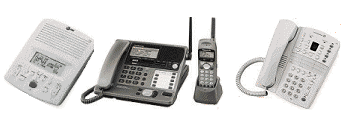|
|
|
Answering machines and answering machine/phone combos
 |

We'd love to hear what you think of our site
Email us
|
|
This section of our catalog contains answering systems from the simplest 1-line basic home answering machine to multi-line units for office use. NOTE: We have also listed cordless phones with built-in answering systems in this section as well as in our cordless section.
Shop for standalone answering machines
Shop for corded phone/answering machine combos
Shop for cordless phone/answering machine combos
Integrated vs Non-Integraded
Answering machines are most often integrated with either cordless or corded phones to provide a more compact and better featured and ultimately less expensive product.
Advantages of an integrated answering system include space savings and integrated features like message management and call screening from a cordless handset, message forwarding to another number (cell phone or a pager) and many others.
Digital vs. Tape
Modern answering systems use a digital chip to process voice signals, which are stored in memory as a stream of bits. This method differs from that used by their electromechanical predecessors, which used magnetic tape for both outgoing and incoming storage.
We at Phone Source feel that digital technology is on balance better than tape. Furthermore, as manufacturers have switched from tape to digital on all but their least-expensive models, there are few situations we can think of where we'd recommend a tape answering machine over a digital one.
Here's why:
- First, digital machines have no moving parts to wear out and are therefore likely to give long service. Contrast this with tapes, pulleys, rollers, drive belts, gears, and motors on a typical tape machine. And while top brands like Code-a-phone and Panasonic made excellent mechnical tape machines, the tape machines of most of the mass-market manufacturers had limited lifetimes.
- Second, digital machines are simply easier to use: like a CD player, a digital unit can move back and forth between messages with the touch of a button. Contrast this with the need to rewind or fast forward a tape, pausing every few seconds to see if you've found the right spot on the tape.
- Third, digital machines can offer advanced features such as mailboxes and message transfer, which are especially invaluable to business users.
- Fourth, in multple-user environments (offices or home use with multiple room-mates or family members) digital machines make it much easier to share a single answering machine, without the need for eveyone to wade through each other's messages.
- Last, sound quality on digital machines remains constant throughout the lifetime of the machine. Contrast this with tape machines where head wear, capstan wear, and tape wear all cause a gradual worsening of sound over time.
It's true that early models of digital answering machines had generally terrible sound quality -- some were so bad that you could only guess at what was being recorded! But, current models are much better, with the brands we carry approaching analog tape quality.
There is one disadvantage of digital, but it only applies to a handful of customers: those who may want/need to permanently archive their messages; while a digital machine can save a nessage, it cannot write it out to a tape, which can then be stored.
With that one negative and, given its greatly-improved sound quality and other advantages, we feel that digital is the best technology for answering machines.
WebMaster: David Cook (Last update: 2/18/2002)
Email: [email protected]
154 Middle Street, Portland ME 04101 USA
PHONE (207) 774-4488 FAX (207) 774-0103
|
|
|



